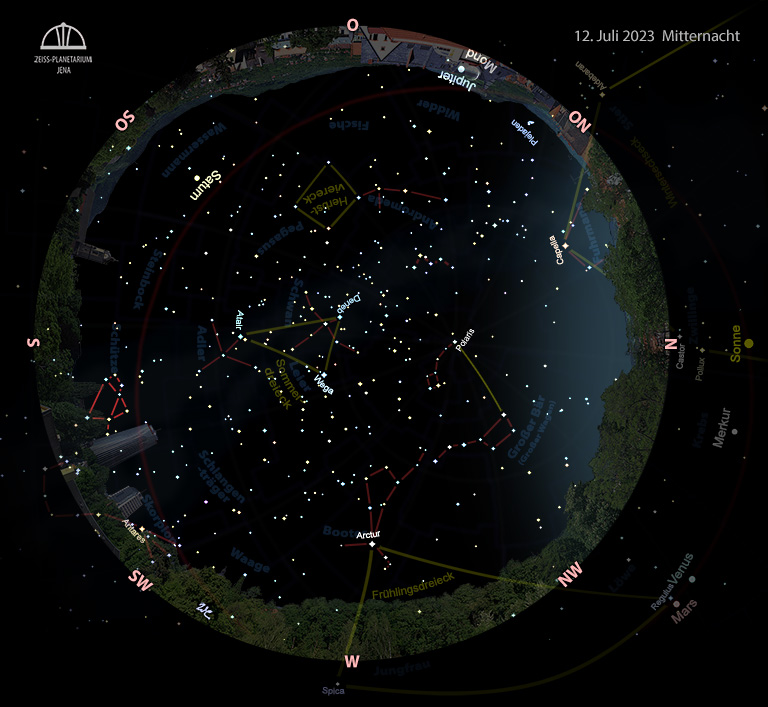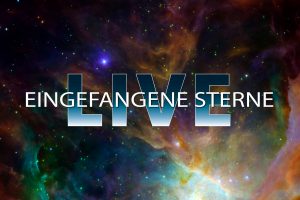4 Planeten
Unsere Erde erreicht am 6. den sonnenfernsten Punkt ihrer Bahn. Trotzdem herrscht bei uns Hochsommer, der helle Tag ist immer noch länger als 15 Stunden. Die Sonne zieht am 21. Juli vom Tierkreissternbild Zwillinge zum Krebs.
Vollmond ist am 3. Juli, Neumond ist am 17.
Die auffällig helle Venus ist schon in der Abenddämmerung im Westen zu entdecken. Am 7. erreicht sie ihre größte Helligkeit. Sie wird gefolgt vom nicht sehr hellen Planeten Mars. Er ist nur noch bis etwa dem 10. beobachtbar.
Im Südwesten beginnt sich das Frühlingsdreieck vom Abendhimmel zu verabschieden. Nur der relativ hochstehende Arktur wird noch einige Monate rötlich funkeln. Gegen Mitternacht dominieren hoch im Süden die hellen Sterne des Sommerdreiecks: Deneb, der Schwanzstern im Sternbild Schwan – auch als Kreuz des Nordens bekannt, westlich daneben die Wega in der Leier und Richtung Horizont ist es der Atair im Adler.
Östlich folgen die weniger lichtstarken Sterne des Herbstvierecks, das jedoch durch seine markante Form gut zu entdecken ist und nach und nach den morgendlichen Himmel beherrschen wird.
Nach Mitternacht geht Saturn im Osten auf. Er wird ab Monatsende zum Planeten der ganzen Nacht. Jupiter folgt in der Morgendämmerung in östlicher Richtung und wird nun zum Planeten der zweiten Nachthälfte.
W. Don Eck
Zeiss-Planetarium Jena
The starry sky in July 2023
4 planets
Our earth reaches the furthest point of its orbit from the sun on the 6th. Nevertheless, it is high summer here, the bright day is still longer than 15 hours. The Sun moves from the zodiac constellation Gemini to Cancer on 21 July.
Full moon is on 3 July, new moon is on the 17th.
The conspicuously bright Venus can already be seen in the west at dusk. It reaches its greatest brightness on the 7th. It is followed by the not very bright planet Mars. It is only observable until about the 10th.
In the southwest, the spring triangle begins to say goodbye to the evening sky. Only the relatively high Arcturus will continue to twinkle reddishly for a few months. Towards midnight, the bright stars of the Summer Triangle dominate high in the south: Deneb, the tail star in the constellation Swan – also known as the Northern Cross, to the west next to it Vega in Lyra and towards the horizon it is Atair in Eagle.
To the east follow the less bright stars of the Autumn Quadrilateral, which is nevertheless easy to spot due to its distinctive shape and will gradually dominate the morning sky.
After midnight Saturn rises in the east. It becomes the planet of the whole night from the end of the month. Jupiter follows in an easterly direction at dawn and now becomes the planet of the second half of the night.
W. Don Eck
Zeiss-Planetarium Jena
Eingefangene Sterne – Live
Mi · 05.07.2023 · 19:30 Uhr
Der Sternhimmel über Jena und monatlich wechselnde Themen
Wir berichten live über den aktuellen Sternhimmel und helfen Ihnen dabei Sterne und Sternbilder zu entdecken. Weiterhin informieren wir Sie über die neuesten Entdeckungen und Entwicklungen in Astronomie sowie bahnbrechende Erkenntnisse über unser Universum und aktuelle Unternehmungen in der Raumfahrt. Monatlich vertiefen wir ein spezielles Thema. Ausdrücklich erwünscht sind Ihre Fragen, Anregungen oder Themenwünsche, die Sie an sternelivefragen@planetarium-jena.de richten oder live in der Veranstaltung äußern können.
Thema im Juli: Die Erde aus dem All
Prof. Dr. Chris Schmullius & Team (Uni Jena)
Auf dem Weg zum Mond entdeckten wir unseren Planeten. Seit 50 Jahren schauen wir mit Satellitenaugen auf die Erde. Der Vortrag schlägt den Bogen von der Fernerkundung mit Satelliten zu Feldforschungen auf verschiedenen Kontinenten.
Captured Stars – Live
Wed – 05.07.2023 – 7:30 pm
The starry sky over Jena and monthly changing topics
We report live about the current starry sky and help you to discover stars and constellations. Furthermore, we inform you about the latest discoveries and developments in astronomy as well as groundbreaking findings about our universe and current ventures in space travel. Every month, we delve into a special topic. We expressly welcome your questions, suggestions or topic requests, which you can send to sternelivefragen@planetarium-jena.de or express live during the event.
Topic in July: The Earth from Space
Prof. Dr. Chris Schmullius & Team (Uni Jena)
On the way to the moon we discovered our planet. For 50 years we have been looking at the Earth with satellite eyes. The lecture will cover a range of topics from remote sensing with satellites to field research on different continents.



